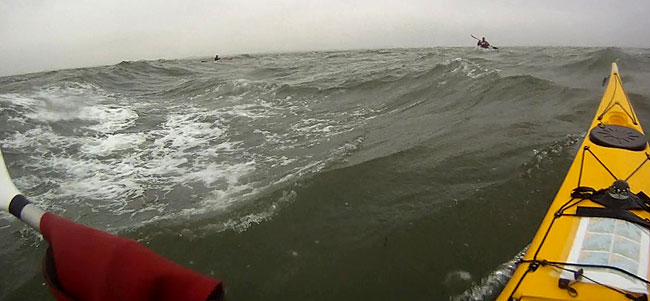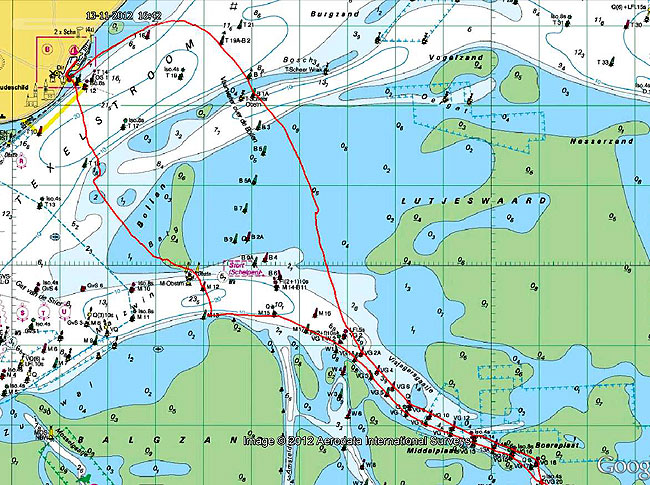13-11-2012
Today I paddled the Pilgrim for the first time at sea. But the short time I paddled her at the Grevelingen, a month ago, gave me confidence to take her for this first test-session to the Texelstroom; starting the trip in Den Oever. The wind was average SW-4 bft with some periods SW-5bft. Such a wind against a current of 2,3 knots gives an interesting sea.

The seat is rather comfortable with my knees fitting exactly in 2 bubbles in the deck on both sides of the cockpit.
The deck is rather low because my feet were almost locked between deck and bottom. Maybe because I wear shoes of size 44 (for fitting over my drysuit socks)
At first I wondered if I was too big for this kayak because she felt if I was "top-heavy". Probably I had to get used to this kayak and her stability. I think that the initial stability is good, but not a very stable platform. The secondary stability is not bad but the end of the stability curve is a bit abrupt, meaning the stability, when edged, changes quickly in zero. But at the end of the day I had no problems with this any more. But it is a different behavior compared to other kayaks. The bottom is very pronounced; almost hardchined in the midsection. I can imagine this the explanation for this behavior. But on the other hand; these hardchines makes her very obedient in following your paddle-corrections. However, other test-sessions will follow and probably give more information on this.
On our first leg of the trip we had a following sea, while the current came from our right-side. We did have fun in surfing the waves. The Pilgrim surfed well and did not need very much power to get her on surfing-speed. I surfed her with the retractable skeg completely down. It was not easy in the waves of today to surf her straight on the wave. Mostly I surfed diagonally on a wave moving to left or right.
The Pilgrim only slightly weathercocks on the following 4bft.-wind and I could easily trim the kayak with the retractable skeg.
Entering the Texelstroom we traversed on the strong current to the other side. In the middle we met high, irregular waves, sometimes cresting a bit. Veru good circumstances for testing a seakayak! :smile:
The Pilgrim behaved very well in his soup keeping her bow almost dry. The bow has rather much volume; I guess designed for waves like this. It was easy to keep her on course.
On the other side of the Texelstroom the waves were lower and shorter. On these waves and against the wind, the Pilgrim was slowed down by each wave giving also more spray than my companions' kayaks. The advantage of the voluminous bow in big water was a disadvantage here in shorter waves. So here is the old story true again: that everything in life is a compromise.
At first I had to apply a lot of energy preventing the Pilgrim to leecock. I had pushed the lever, for controlling the retractable skeg , forwards to pull up the skeg. As I could not see the lever I had pushed against the wrong spot leaving the skeg a bit down.
Because I could manage, keeping the Pilgrim on course with this handicap, this is good news because this means that when the Pilgrim really leecocks you are not in problems.
After retracting the skeg completely it was a delight to paddle the Pilgrim and keeping her in course in this wind of approx. 5 bft. In these headwinds almost every kayak leecocks a bit but the Pilgrim is maneuverable enough to keep her on course so easily.
Normally I can speed up a bit to come closer to my companion: but not with the Pilgrim now in these sticky waves who were holding me back. I just managed to keep enough speed to keep up with my friends.
The lever for controlling the retractable skeg is built in on the side of the kayak; exactly on the seam from deck to hull. Besides being not visible for visually checking position of the skeg as mentioned above, I repeatedly moved with my hand in the cold water when controlling the skeg, which is a disadvantage in the time of the year.
After a break we crossed the Texelstroom again on a deeper part now crossing for a while on high waves ; a bit like clapotis. There was a small tendency to wander a bit of course. To the left, you could call this leecocking, but I saw my friends doing the same thing. And I could still make not much speed in the Pilgrim.
The last leg of our trip was easy without much waves. We only had to deal with the current to navigate to Den Oever again. Now the waves almost were gone, it was much easier to speed up the Pilgrim as she was not teased by sticky waves.
At the end of the trip my lower back was rather stiff. May be this is the result of the NDK-seat having no back-rest-band. Instead there is a conical piece of foam pushing low in your back. This is a personal issue because you hear people being happy to paddle without a back-band and also other people not getting used to this seat without a backrest-band. Every back is different I guess. But I have seen NDK-kayaks in which such a back-rest was fitted by the owner afterwards. So, don't worry about this.

